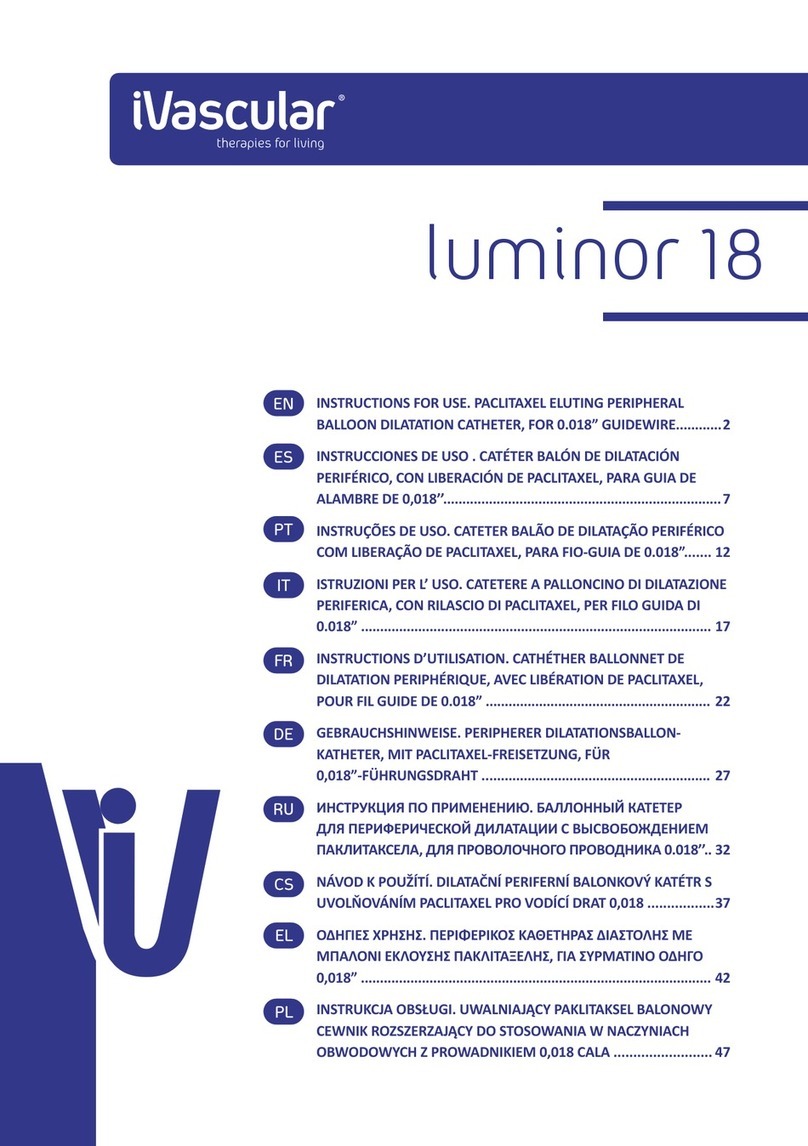
8
oceanus 35
4. Advertencias
-El disposivo debe usarse por médicos con experiencia y que conozcan la técnica de la angioplasa
transluminal percutánea (ATP).
-La intervención percutánea debe ser realizada en hospitales equipados con medios de emergencia
para realizar operaciones de cirugía abierta o en hospitales con fácil acceso a otros hospitales que
puedan realizar esta cirugía.
-El producto es de un solo uso. No debe reesterilizarse ni reulizarse una vez el procedimiento se ha
terminado. La reulización del producto en otro paciente puede causar contaminación cruzada, infec-
ciones o transmisión de enfermedades infecciosas de un paciente a otro. La reulización del producto
puede causar alteraciones del mismo y limitar su efecvidad.
-El producto se suministra estéril. Comprobar la fecha de caducidad y no usar productos que hayan
sobrepasado dicha fecha.
-Inspeccionar el envase antes de abrirlo. Si se encuentra algún defecto o el envase está dañado, des-
echar el producto.
-Emplee técnicas asépcas cuando el producto se extraiga del envase primario.
-Elegir el diámetro del balón en función del diámetro de la arteria a tratar. No introducir un balón cuyo
diámetro sea superior al de la arteria a tratar.
-No secar con gasas.
-No exponer el producto a solventes orgánicos, ni a medios de contraste no indicados para uso intra-
vascular.
-No usar aire ni medios gaseosos para inar el balón.
-Avanzar el producto sobre la guía de alambre con visión de uoroscopia. No permir el avance del
producto sin la guía de alambre en su interior.
-No manipular, avanzar o retraer, el catéter ni la guía de alambre, cuando el balón está inado.
5. Precauciones
-Administrar al paciente la terapia médica adecuada: ancoagulantes, vasodilatadores, etc, de acuerdo
con el protocolo de inserción de catéteres intravasculares.
-Antes de su uso, comprobar la talla y adecuación del catéter al uso desnado.
-Proceda con sumo cuidado para no dañar el catéter en su avance.
-El balón debe ser inado con una mezcla de solución salina y líquido de contraste (preferentemente
50/50 aunque puede disminuir la proporción de líquido de contraste en balones de gran tamaño).
-No exceder la presión máxima recomendada (RBP) ya que el balón podría explotar.
-Si durante el avance, se nota alguna resistencia, cesar el avance y determinar la causa antes de con-
nuar.
-Si nota resistencia en la rerada del catéter, se recomienda rerar el catéter balón, la guía de alambre
y el introductor como una sola unidad.
-Almacenar en lugar fresco y seco, lejos de la luz directa del sol.
-Después de su uso, este producto puede suponer un peligro biológico. Manipúlelo y deséchelo con-
forme a las práccas médicas aceptadas, y a las leyes y normavas locales, estatales o federales per-
nentes.
6. Posibles efectos adversos / complicaciones
Entre los posibles efectos adversos y/o complicaciones que se podrían manifestar antes, durante o después
del procedimiento, se encuentran:
INSTRUCCIONES DE USO
CATÉTER BALÓN DE PREDILATACIÓN PERIFÉRICO, PARA GUÍA DE ALAMBRE DE 0.035”.




























